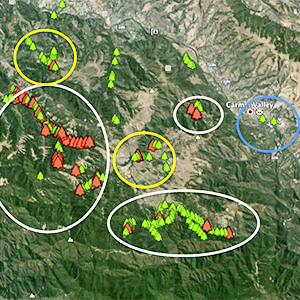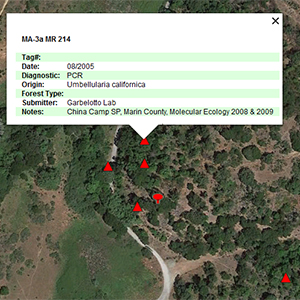Most likely the redwood is experiencing symptoms related to cycles between drought and rainy periods. However, if there is a significant presence of California bay laurels intermixed with redwoods, there may be enough pressure from the SOD pathogen to also cause problems on redwoods, both native and exotic. Any SOD oak infections are likely directly connected to bay laurels, as both oaks and redwoods can become infected by the large number of spores produced on bay laurel leaves. The pathogen does not move from oaks to other trees.
The most important part of ensuring that tools will not spread SOD is to be sure that no organic debris or soil is present on the tools. This applies to all portions of each tool, including parts that may not be visible (like the return of a chain in a chainsaw or the interior of a tree chipper). For more information on cleaning tools and equipment, go to https://nature.berkeley.edu/garbelottowp/?p=1208.
It is always advisable to first have a tree tested before removal to be sure P. ramorum is present. If you are noticing symptoms in spring, attend a nearby SOD Blitz for information on sampling and lab submissions. For more information, go to sodblitz.org.
Bay shoots do not carry P. ramorum because the pathogen is not systemic in bay. Each leaf is infected independently. Additionally, there is no root infection in most P. ramorum hosts, particularly California bay laurel. However, when bays re-sprout, they may be re-infected.
When trying to determine if an oak may have SOD (caused by the plant pathogen Phytophthora ramorum), the first step is to determine if the tree lies within 1 km of a known outbreak. This can be done by accessing SODMAP at www.sodmap.org or by uploading the free “SODMAP Mobile” app to your smartphone. Stand next to the tree in question and tap the risk button. A response of moderate or high risk would suggest Phytophthora ramorum may be present. The next step is to confirm it is indeed P. ramorum. Make sure the oozing is not wetwood, or bacterial flux, which typically is associated with much more oozing and often has an unpleasant odor. Bacterial flux usually has a watery secretion running down the trunk that originates from a wound or branch crotch. If all symptoms align with SOD, the next step is to test for P. ramorum. If a symptomatic California bay laurel tree is within 10 m of the oak, collect symptomatic bay leaves for testing. This is not a definite diagnosis for the oak, but it may be an acceptable one that does not involve wounding the oak tree for sampling. Bay-based diagnosis for an oak may be less accurate after multiple years of drought, as bays may actually turn from SOD positive to SOD negative during extended dry conditions. One can get bay leaves tested by participating in one of the annual SOD blitzes (www.sodblitz.org) or by submitting samples to the California Department of Food and Agriculture. Testing the oak requires debarking a portion of the tree until the margins of the putative SOD lesion under the bark are visible and then plating the margins of the lesion on Phytophthora-selective medium for laboratory analysis.
Survival of P. ramorum (SOD pathogen) in wood chips depends on a few factors:
- Were the chips allowed to become wet?
- What size are the chips?
- Is green waste present?
- What time of year was the wood chipped?
- Where in California are the chips located?
Chips that are piled wet or tarped and include infected green waste (e.g. bay laurel leaves) may support pathogen viability for over 1 year, especially in mild coastal areas. If the wood is chipped in the summer and early fall and the chips are not piled, but rather broadcast in a 1-inch layer in a dry and sun-exposed area, pathogen viability may only be supported for a few weeks, especially if in hotter interior areas.
SOD Blitzes include a training session for blitz volunteers on SOD and proper sampling, followed by time in the field for collecting and marking sample locations. All necessary collection materials are provided to volunteers during the training session for use either the same day of the training or the day after. All samples are to be dropped off at a designated location (location announced at the training session). There are approximately 20 SOD Blitzes in areas of California that have sudden oak death or at risk of disease establishment. Most of the training sessions are offered on Saturday mornings. SOD Blitz schedules for the coming year are posted annually during the last week of January at www.sodblitz.org.
The symptoms on your oak may be caused by a range of issues. If oozing is accompanied by the presence of fine sawdust, then the tree is dying. Even if it is still green you may want to consider removing it if its failure may cause harm to people or property. The fine sawdust is caused by beetles tunneling in the tree. Oaks are only attacked by beetles when dying. If no sawdust is present, then the tree’s condition may be reversible.
Unfortunately, it is difficult to determine what may be the cause of the symptoms you describe. Sudden Oak Death (SOD) can attack an oak tree if California bay laurel is within 60 feet of the oak. You can use the free SODmap Mobile App to determine if you are in a high or moderate risk zone for SOD. To find out how to do that, go to www.sodmapmobile.org. There is also a YouTube video you can watch at https://youtu.be/zE0_q3EmIfs. If the information you gather suggests that it may be SOD, then repeat the phosphite bark application (such as Agri-Fos® combined with Pentra-Bark®) in the fall between October 30th and December 15th. You may also want to consider removal of bays within 30 feet from the oak. Go to http://nature.berkeley.edu/garbelottowp/?page_id=909 to find out about upcoming treatment training sessions to learn more about treatment options. If there are no bays within 60 feet of your oak and the SODmap mobile risk is low, then it likely isn’t SOD.
If you have watered your oak, it may be a root disease such as the oak root fungus or Phytophthora cinnamomi root disease. Make sure you stop watering and expose the upper root system to the air to slow disease progression. If you have never watered your oak, then it may be a secondary disease brought on by the long drought (ex. oak die-back fungus). These are diseases that are strongly affected by the genetics of the tree and weather conditions. In this case, you may want to try watering the tree now and then once again in 2 weeks. Then water once a month starting October 15th. Do not water between July 10th and October 15th. Watering should be done using a low flow approach to ensure that the soil gets wet up to 1 foot down and that no flooding of the tree ever occurs. Unfortunately, if the secondary disease is too advanced, despite all efforts, the tree may still die.
The revised SOD treatment recommendations can be found at: https://nature.berkeley.edu/garbelottowp/?p=1039.
Download sod map mobile and tap the risk button. If the risk shows up as high or moderate, call an arborist listed at http://www.suddenoakdeath.org/diagnosis-and-management/arborists-applicators/. If you get an insufficient data response, then see if you have any CA bay laurel trees within 20 yards of the oak. If you find any, do they have possible P. ramorum (pathogen that causes sudden oak death) symptoms (symptomatic photos: http://www.suddenoakdeath.org/library/photos/plant-symptom-photos/; host information: http://www.suddenoakdeath.org/diagnosis-and-management/hosts-and-symptoms/). If you do find questionable symptoms on bay, again, call an arborist listed at http://www.suddenoakdeath.org/diagnosis-and-management/arborists-applicators/ for a site visit.








